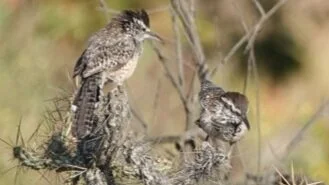By Dessi Sieburth
YOUNG BIRDERS: Charismatic and Clever—The Cactus Wren (Campylorhynchus brunneicapillus)
For the chapter newsletter of Los Angeles Audubon Society, The Western Tanager, Vol. 86 No. 6, July August 2020.
Cactus Wren on cholla cactus. | Illustration by Dessi Sieburth
The Cactus Wren is appropriately named because this large wren depends on cacti for nesting and foraging. There are two main populations of the Cactus Wren—desert and coastal. The desert population ranges from southeastern California to central Texas, and south to Michoacán, central Mexico, and the coastal population ranges from southern Ventura County to northern Baja California. Cactus Wrens in the desert prefer dense stands of Joshua Trees or saguaros, while on the coastal slope, Cactus Wrens prefer dry hills dotted with prickly pear and cholla cacti.
Cactus Wren nest in cholla cactus at Big Tujunga Wash near Orcas Park, Los Angeles County, March 15, 2020. | Photo by Dessi Sieburth
Cactus Wrens often perch out in the open, but they can also be secretive as they skulk through cacti, so the best way to detect them is to learn their low churring call, which sounds almost like a car engine trying to start. In addition to knowing the call, one of the best ways to find the wrens is to look for large ball-shaped lumps of sticks and grasses within a cactus—these are the nests of the Cactus Wren. Cactus Wrens can be identified by their large size (they are the largest wren in the United States) as well as the black spots on the breast and the white eyebrow. Males and females look alike, and juveniles are slightly paler. Cactus Wrens are perfectly adapted to their dry environment. They get nearly all of their water from food, which consists of insects and cactus fruit. They place their nests deep within a cactus, which protects the nest from predators. They often make multiple “dummy” nests to distract predators and provide themselves with a safe roosting site. Due to these precautions, Cactus Wrens have a high reproductive success, and they can nest up to three times per year.
White arrows show three Cactus Wren nests, and at least two are “dummy” nests. Big Tujunga Wash near Orcas Park, Los Angeles County, March 15, 2020. Photo by Dessi Sieburth.
Neighborhood adjacent to Cactus Wren habitat, Big Tujunga Wash near Orcas Park, Los Angeles County, March 15, 2020. | Photo by Dessi Sieburth.
Though still considered a common species, the Cactus Wren has declined by over 55 percent over the last 50 years. This decline has taken place largely in the coastal populations, where development has rapidly eradicated nearly all suitable habitat. Within Los Angeles County, for example, the species was formerly found in the Baldwin Hills, in Castaic, and in the San Fernando Valley, where development has destroyed nearly all chaparral habitat. An extensive Cactus Wren survey in 2012 found that there were only three populations in coastal Los Angeles: the Palos Verdes Peninsula (28 pairs), the Big Tujunga Wash (6 pairs) and the eastern San Gabriel Valley (122 pairs).
Cactus Wrens at Big Tujunga Wash, near Orcas Park on September 18, 2019. | Photo by Brad Rumble.
Development has threatened the population in parts of the Big Tujunga Wash. The creation of Angeles National Golf Club in 2004 destroyed much habitat on the east side of the wash that was previously occupied by at least five pairs of Cactus Wrens. No mitigation for the Cactus Wrens occurred, and after the creation of the golf course, the wrens were only found occasionally in the vicinity of the golf course, with the last nesting reported in 2011. The last sighting of a Cactus Wren in this area was north of the golf course on November 12, 2017.
This Cactus Wren was seen and photographed north of Angeles National Golf Club by Brad Rumble on November 12, 2017.
The recent increase in wildfires especially threatens coastal Cactus Wren populations. For example, the six pairs of Cactus Wrens inhabiting the Big Tujunga Wash near Orcas Park were reduced to just one to two pairs following the 2018 Creek Fire, and no Cactus Wrens have been seen in the area since September of 2019. It appears that this isolated population has disappeared. Small patches of cacti remain in this area, but recolonization seems unlikely, because Cactus Wrens require large, intact stands of cacti.
The 2018 Creek Fire destroyed much of the Cactus Wren habitat in the Big Tujunga Wash near Orcas Park. | Photo by Beatrix Schwarz
How can we help coastal Cactus Wren populations? The remaining Cactus Wren habitat in coastal Los Angeles County needs to be protected from development. New Cactus Wren habitat needs to be created, and the wren’s use of the habitat needs to be monitored and studied. We all can help these birds by reporting our bird sightings to eBird, the database of the Cornell Lab of Ornithology, which keeps track of bird populations. Conservationists can use this data to help declining species, like the Cactus Wren.
Thanks to Kimball Garrett and Mickey Long for providing history on the Cactus Wren habitat prior to the creation of the Angeles National Golf Club, as well as Brad Rumble for providing some of the photos.
References:
Cooper, D.S., Hamilton, R.A., and Lucas, S. (2012) A population census of the cactus wren (Campylorhynchus brunneicapillus) in coastal Los Angeles County.
Western Birds Hamilton, R.A., Proudfoot, G.A., Sherry, D. A., Huntington, and Johnson, L. J. (2011). Cactus Wren (campylorhynchus brunneicapillus), version 2.0. In Birds of North America (P. G. Rodewald, Editor). Cornell Lab of Ornithology, Ithaca, NY, US








